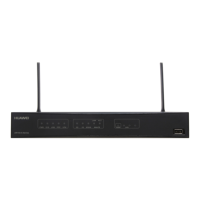#
return
4.8.4 Example for Configuring Remote Flow Mirroring
The remote flow mirroring function allows you to monitor the packets with the same
characteristics on a remote device.
Networking Requirements
As shown in Figure 4-10, company A's branch network connects to Ethernet1/0/0 on the egress
gateway RouterA, and the headquarters network connects to Ethernet1/0/0 on the ingress
gateway RouterB. An observing device connects to RouterB on the headquarters network. The
company needs to monitor all the IPv4 packets from host 10.1.1.2/24 on the branch network.
NOTE
The hosts on the enterprise network use private addresses; therefore, a GRE tunnel must be configured on
the public network to ensure communication.
Figure 4-10 Remote flow mirroring network
Tunnel
RouterA
Monitoring device
192.168.2.2/24
Branch of
company A
IP network
RouterB
HostA
192.168.1.2/24
Headquarters of
company A
Eth 1/0/0
192.168.2.1/24
Eth 1/0/0
192.168.1.1/24
Eth 1/0/1
20.1.1.1/24
Eth 1/0/1
30.1.1.1/24
Tunnel 0/0/1
10.1.1.1/24
Tunnel 0/0/1
10.1.1.2/24
20.1.1.2/24
30.1.1.2/24
Configuration Roadmap
The configuration roadmap is as follows:
1. Configure IP addresses and default routes for all interfaces on RouterA and RouterB, as
shown in Figure 4-10.
2. Configure a GRE tunnel to allow the hosts with private addresses to communicate over the
public network.
Huawei AR150&200 Series Enterprise Routers
Configuration Guide - Device Management 4 Mirroring Configuration
Issue 02 (2012-03-30) Huawei Proprietary and Confidential
Copyright © Huawei Technologies Co., Ltd.
86

